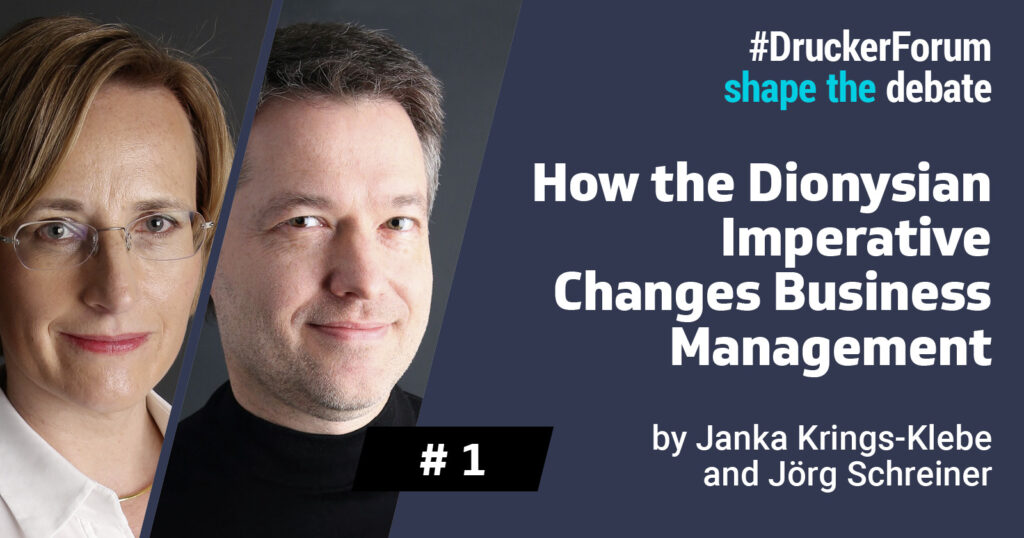
While the landscape shifts beneath our feet – marked by disruption, blurred boundaries, and accelerating change – many organizations still cling to outdated instincts. For generations, management has been guided by a quest for order and predictability, trying to tame uncertainty through rigorous processes and disciplined decision-making. This inclination aligns well with what Nietzsche, in The Birth of Tragedy, called the “Apollonian” impulse: the drive toward harmony, rationality, and controlled form. Yet Nietzsche also highlights a contrasting “Dionysian” force – one that brings forth ecstasy, chaos, and the powerful wellspring of creativity. Balancing these two impulses, he claimed, was vital for the brilliance of ancient Greek tragedy, where structure and chaos coexisted to produce artistic greatness.
Today, that tension resonates in a business environment defined by rapid change. The “Dionysian imperative” in management speaks to the need for spontaneity, experimentation, and a willingness to embrace the unpredictable – at a time when siloed structures and inflexible planning can inhibit genuine innovation. Over the past few decades, signs of this tension have become increasingly visible. Companies that cling exclusively to Apollonian stability often find themselves blindsided by sudden shifts. The Dionysian imperative instead channels the energy, improvisation, and entrepreneurial flair necessary to thrive.
Chaos Is Not the Enemy
When people hear of Dionysus – the Greek god of wine, fertility, and revelry – they may imagine only chaos at odds with managerial discipline. Yet Nietzsche reminds us that true flourishing does not lie in disorder alone; it emerges from blending chaos with structure. In organizational terms, the Dionysian imperative calls on leaders to create space for radical ideas, collective problem-solving, and fluid forms of collaboration that take root wherever opportunity exists. This orientation departs from the traditional top-down model, where decisions filter slowly through a hierarchy. In an era of real-time data, AI-driven insights, and global interactions, valuable insights often emerge from unexpected places. When managers encourage distributed experimentation, the organization begins to operate less like a machine and more like a living ecosystem – adaptive, decentralized, and capable of self-renewal.
The Paradox of Agility
Such responsiveness aligns with the notion of “antifragility” – the capacity to grow stronger amid volatility and disruption. Apollonian companies attempt to limit uncertainty through planning and well-crafted buffers. While seemingly useful, they might also create a false sense of security in a world where upheaval can come from unexpected quarters. The Dionysian viewpoint treats uncertainty as fuel for progress. It views experimentation not simply as a means for incremental enhancement but as a critical element of survival. Crucial to this approach is a sense of shared purpose. Without a clear reason for existing, creative energy risks dispersing into unproductive directions. A shared sense of purpose becomes essential as a subtle force of coherence. It allows innovation to unfold with direction rather than drift. Over time, this approach yields an enterprise that does more than endure under stress, it evolves because of it.
A Dance, Not a Tug-of-War
Technology amplifies the importance and the feasibility of this transformation. Real-time analytics, AI-assisted decisions, and borderless digital platforms have quickened the tempo at which organizations must respond. One unprepared for rapid change might adhere doggedly to familiar routines or chase every new trend frenetically. Neither is productive.
The Dionysian imperative charts a middle route: using technology to foster interconnected teams that self-organize around emerging patterns. These teams leverage AI-driven insights to identify untapped markets, reimagine internal processes, or devise offerings that bypass established categories. Human creativity remains the engine: technology is the connective tissue. Leaders play a subtle but crucial role – not as commanding authorities, but as facilitators of alignment, trust, and flow. This is not about learning to choreograph the tension between control and chaos. The dynamic interplay of freedom and coherence, of exploration and focus, is what brings the Apollonian and Dionysian into productive dialogue.
Beyond the Metaphor: A New Organizational Model Emerges
The Dionysian imperative calls for the structures surrounding it must evolve accordingly. Traditional models often constrain the very forces organizations now need to unleash.
As boundaries between industries, functions, and even organizational identities blur, it becomes clear that adaptability no longer comes from control alone, but from connectivity, permeability, and the ability to adapt in real time. The organization must be capable not only of responding to change but of sensing and shaping it from within and beyond its formal borders.
This shift suggests a different kind of organizational architecture – one that behaves less like a machine and more like a complex, living system. Rather than suppressing ambiguity, it integrates diverse signals and interactions into its evolution. Instead of enforcing strict lines, it cultivates productive overlaps. Over time, such a system can transcend the trade-offs between order and chaos by weaving them into a dynamic source of renewal.
From Mechanism to Organism
What begins as a philosophical tension becomes a strategic necessity. The Dionysian imperative is not a rejection of structure – it is a call for forms that can breathe. Organizations that embody this mindset shift from mechanistic efficiency to creative vitality. The benefits are tangible: faster innovation cycles, deeper engagement, and collaborative networks that extend far beyond internal departments.
Such organizations don’t merely survive disruption – they evolve with it. They are sensitive to change but not ruled by it. They cultivate coherence without imposing rigidity. In short, they behave more like ecosystems than engines – alive to their environment, shaped by participation, and capable of continuous transformation. They are mirroring the ancient dance of order and vitality that Nietzsche described.
We’ve traced the philosophical roots of this imperative – and glimpsed the kind of organization it calls into being. The next step is to understand how this plays out in the real world: not just as metaphor, but as method.
Looking Ahead
In the next article, we’ll explore how pioneering companies are already building these ecosystemic structures – how they distribute authority, encourage emergence, and align around shared purpose without reverting to top-down control.
Until then, consider this:
What if your organization is only one node in something much larger? What would change if we stopped designing companies as self-contained entities and started designing them as contributors to evolving systems of value? How might your company begin to behave less like a system of functions and more like a living contributor to a broader ecosystem?
The Dionysian imperative is not just about internal reinvention. It’s an invitation to reimagine how we participate in the world – how we relate, create, and shape what comes next.
– – – – – – – – – – –
Acknowledgment
Many thanks to Zhang Ruimin for his generous endorsement of our upcoming book, The Antifragile Organization: From Hierarchies to Ecosystems (LID Publishing, May 2025), which inspired this article series.
About the authors:
Janka Krings-Klebe and Jörg Schreiner are the founders of co-shift GmbH, where they support organizations in building collaborative ecosystems and navigating complex transformations. Their forthcoming book explores how organizations can move beyond control-based models to become adaptive, opportunity-driven, and built for emergence.

